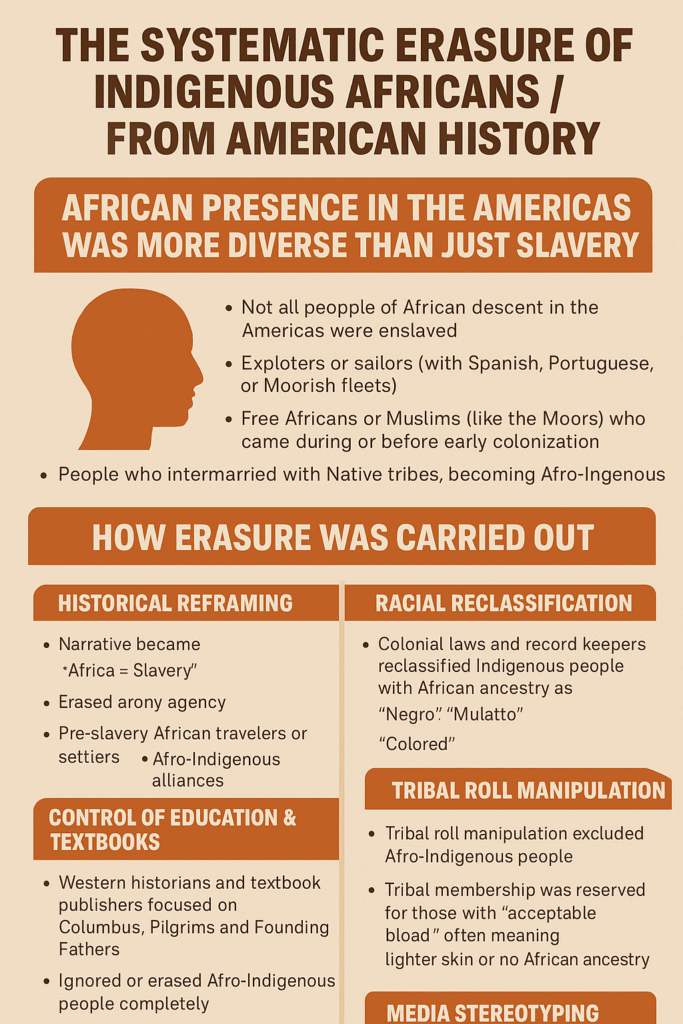A growing body of research and advocacy highlights how Western Europeans and later European Americans deliberately erased the presence of Indigenous Africans from American history. This erasure was not accidental but carried out through a combination of colonial violence, legal manipulation, racial reclassification, and historical suppression, with lasting consequences for how African and Afro-Indigenous identities are perceived today.
Beyond Slavery: The African Presence in the Americas
Contrary to the dominant narrative, Africans in the Americas were not solely enslaved laborers. Some arrived as explorers, sailors, or Muslims traveling with early European fleets. Others came freely and intermarried with Native tribes, creating Afro-Indigenous communities. Some scholars even argue for pre-Columbian African contact, though that remains debated.
Yet Western historiography reduced these complex identities to a single word: “slave,” flattening the richness of African contributions to American history.
Methods of Erasure
The process of erasing Indigenous Africans from history followed several systematic steps:
-
Historical Reframing: Africa was equated exclusively with slavery, ignoring free Africans, Afro-Indigenous alliances, and contributions to agriculture, infrastructure, and resistance movements.
-
Racial Reclassification (“Paper Genocide”): Colonial and later U.S. laws reclassified Afro-Indigenous people as “Negro,” “Mulatto,” or “Colored,” stripping them of tribal affiliation and land rights. Laws like the Virginia Racial Integrity Act of 1924 institutionalized this erasure.
-
Manipulation of Tribal Rolls: During allotment and federal recognition processes, Afro-Indigenous people were excluded from tribal rolls, with “acceptable blood” often defined as excluding African ancestry. This legacy continues in disputes over tribal citizenship today.
-
Suppression of Oral Histories: Boarding schools, enslavement, and missionary work disrupted oral traditions and languages, erasing cultural memory and reinforcing the European-written version of history.
-
Education and Textbooks: American schools emphasized Columbus, Pilgrims, and the Founding Fathers while reducing Africans to “slaves” and ignoring Afro-Indigenous groups entirely.
-
Media Stereotyping: Popular culture reinforced a binary narrative Native as “red-brown” and African as enslaved leaving no room for Afro-Indigenous identities.
Erased Communities and Identities
Several Afro-Indigenous groups suffered historical erasure or marginalization, including:
-
Black Seminoles: Descendants of escaped Africans and Seminole Natives, later displaced and stripped of tribal recognition.
-
Lumbee (North Carolina): A tri-racial community still fighting for federal recognition.
-
Mashpee Wampanoag & Narragansett: Dark-skinned members were reclassified as “Black.”
-
Gullah-Geechee (South Carolina/Georgia): Coastal African-descended people with oral Native ancestry largely ignored in mainstream narratives.
-
Garifuna (Caribbean/Central America): Afro-Indigenous descendants of Africans and Arawaks, rarely included in U.S. historical accounts.
Why It Matters Today
DNA evidence, oral histories, and family records continue to reveal the intertwined roots of African and Indigenous peoples in the Americas. However, centuries of systemic erasure have left many unaware of their Afro-Indigenous heritage.
The consequences of this suppression remain visible in disputes over land rights, tribal membership, and cultural recognition. Advocates argue that restoring these erased narratives is essential not only for justice but also for reshaping how America understands itself.


